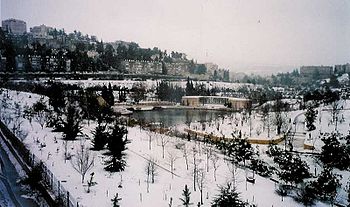
Jerusalem Botanical Gardens
Encyclopedia

The Jerusalem Botanical Gardens (JBG) is located in the neighborhood of Nayot
Nayot
Nayot is a neighborhood in south-central Jerusalem, Israel established in 1960 by a group of English-speaking immigrants.-Etymology:The name Nayot appears mentioned six times in the Bible, in I Samuel .-History:...
in Jerusalem, on the southeastern edge of the Givat Ram
Givat Ram
Givat Ram is a neighborhood in central Jerusalem, Israel. Many of Israel's most important national institutions are located in Givat Ram, among them the Knesset, the Israel Museum, the National Library of Israel and the Israeli Supreme Court.-Etymology:...
campus of the Hebrew University of Jerusalem
Hebrew University of Jerusalem
The Hebrew University of Jerusalem ; ; abbreviated HUJI) is Israel's second-oldest university, after the Technion – Israel Institute of Technology. The Hebrew University has three campuses in Jerusalem and one in Rehovot. The world's largest Jewish studies library is located on its Edmond J...
.
The garden is arranged in phytogeographic sections, featuring flora of various regions around the world. The Jerusalem Botanical Gardens opened to the public in 1985. The tropical conservatory opened in 1986 and the South Africa section was planted in 1989. The Hank Greenspan Entrance Plaza, Dvorsky Visitors’ Center and restaurant were built in 1990.
History
The first plot of land was purchased on Mount ScopusMount Scopus
Mount Scopus , جبل المشهد , جبل الصوانة) is a mountain in northeast Jerusalem. In the wake of the 1948 Arab-Israeli War, Mount Scopus became a UN protected Jewish exclave within Jordanian-occupied territory until the Six-Day War in 1967...
in 1926. Plans for the botanical garden were drawn up by Alexander Eig
Alexander Eig
Alexander Eig was a botanist, one of the first plant researchers in Israel, head of the department of Botany at the Hebrew University in Jerusalem and co-founder of the Jerusalem Botanical Gardens on Mount Scopus.-Life:Born in Schedrin near Minsk, he used to wander in the forests and to join his...
, chairman of the Botany Department of the Hebrew University, based on the flora of the Land of Israel
Land of Israel
The Land of Israel is the Biblical name for the territory roughly corresponding to the area encompassed by the Southern Levant, also known as Canaan and Palestine, Promised Land and Holy Land. The belief that the area is a God-given homeland of the Jewish people is based on the narrative of the...
from Mount Lebanon to the desert. Planting began in 1931. In 1948, in the Israeli War of Independence, access to Mount Scopus and the university campus was cut off. When an alternative campus was built in Givat Ram in 1954, a new botanical garden
Botanical garden
A botanical garden The terms botanic and botanical, and garden or gardens are used more-or-less interchangeably, although the word botanic is generally reserved for the earlier, more traditional gardens. is a well-tended area displaying a wide range of plants labelled with their botanical names...
was planted near the Jewish National and University Library
Jewish National and University Library
The National Library of Israel , is the national library of Israel...
, including a unique collection of Coniferae. In 1962, a rocky hill in the southeastern corner of the campus was planted with conifers from North America. Budgeting was a serious problem until 1975, when the Society of Friends of the Botanical Gardens was established and the garden became a joint project of the university, the Jerusalem Municipality and the Jewish National Fund
Jewish National Fund
The Jewish National Fund was founded in 1901 to buy and develop land in Ottoman Palestine for Jewish settlement. The JNF is a quasi-governmental, non-profit organisation...
. A scientific board was appointed, and architect Shlomo Aronson
Shlomo Aronson
Shlomo Aronson is an Israeli landscape architect. His works range from master plans for reforestation, archaeological parks and freeway planting schemes to urban plazas.-Biography:...
was commissioned to plan the layout. In 1981, the Garden Association was founded, and a board of executives appointed. The garden was opened to the public in 1985. In 1994, it separated from the Hebrew University, and has been managed by the Botanical Garden Association since 1996.
Bonsai
The garden's JapanJapan
Japan is an island nation in East Asia. Located in the Pacific Ocean, it lies to the east of the Sea of Japan, China, North Korea, South Korea and Russia, stretching from the Sea of Okhotsk in the north to the East China Sea and Taiwan in the south...
ese section contains over 150 bonsai
Bonsai
is a Japanese art form using miniature trees grown in containers. Similar practices exist in other cultures, including the Chinese tradition of penjing from which the art originated, and the miniature living landscapes of Vietnamese hòn non bộ...
trees, the largest concentrated collection of bonsai trees in the world.
Bible path
The 500-meter long "Bible Path" is planted with most of the 70 species that scientists have identified as some of the 400 types of plants mentioned in the BibleBible
The Bible refers to any one of the collections of the primary religious texts of Judaism and Christianity. There is no common version of the Bible, as the individual books , their contents and their order vary among denominations...
.
Endangered species
One of the goals of the garden is to create a living gene bankGene bank
Gene banks help preserve genetic material, be it plant or animal. In plants, this could be by freezing cuts from the plant, or stocking the seeds. In animals, this is the freezing of sperm and eggs in zoological freezers until further need. With corals, fragments are taken which are stored in water...
to protect endangered plants in Israel and the region as a whole.

